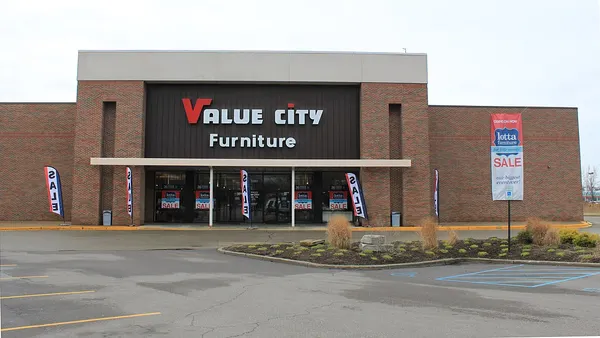Dive Brief:
- Sears has made more moves to open up liquidity in the near-term. The department store retailer announced in filings and a press release Tuesday that it had agreed with a group of lenders led by Bank of America to extend the due date of one of its loans.
- The agreement pushes the maturity date of a $400 million term loan from June 30 2018 to Jan. 20, 2019, with flexibility to push it off to July 2019 under agreed-on conditions, according to a filing with the Securities and Exchange Commission. Sears noted in a press release that it had paid $325 million on the loan in the fourth quarter, bringing the balance down to $400 million. In 2017, Sears has paid a total of $570 million on the loan, according to the company.
- In the release, the retailer also said it had obtained a new secured credit facility through Pension Benefit Guaranty Corporation, which Sears said will allow it to pay $407 million in pension contributions and "for general corporate purposes." The credit facility is secured with 138 Sears properties through a ring-fence arrangement with PBGC.
Dive Insight:
Bit by bit, loan by loan, closed store by closed store, Sears is trying to inch its way to financial health — or at least away from bankruptcy.
The latest news, of a potentially year-long loan extension, takes some pressure off the retailer as it continues grappling with profit losses and dizzying sales declines.
"The extension of the Term Loan improves our short-term debt maturity profile, while the credit facility associated with the PBGC agreement will support our continued commitment to the Company's pension plans while enhancing our financial flexibility," Sears Chief Financial Officer Rob Riecker said of the extension in a statement.
"All of Sears debt matures before 2020, but a lot of its secured debt matures in 2018," Philip Emma, a retail analyst with Debtwire, said in an email to Retail Dive. "If it can continue to maintain collateral coverage levels for its lenders, then it has a chance to buy itself a lot more time."
There is still plenty of long-term pressure on Sears. The company is top among retailers on Fitch's "loans of concern" list for a $1.6 billion outstanding loan. S&P in October downgraded Sears’ debt, citing the retailer’s cash burn and more than the then-$1 billion in loan maturities due in 2018 that at the time they said posed a default risk. S&P analysts wrote then that "compared to peers, ongoing operating performance has been poor," though they also noted Sears' reduction in corporate costs and its "record of accomplishment for asset sales and incremental financings."
Put the loan extension in the latter category. While it may offer financial breathing room in the near term, the long-term problem for Sears is well-known and long-running. Simply, the retailer is hemorrhaging money and customers.
Sears has been able to stave off default for years largely through store closures (there have been around 400 in the past year alone), staff layoffs (numbering in the hundreds this year), asset sales and loans from Lampert's hedge fund ESL Investments, which has provided hundreds of millions of dollars in credit in 2017. To try to revive sales, it's also partnered with Amazon to sell Kenmore products, tested new store formats and revived its holiday catalog.
But despite these efforts, the company is still posting regular, and often steep, sales declines. Most recently, Sears reported third quarter sales fell 26% year-over-year to $3.7 billion. While store closures accounted for a good chunk of that, a dismal 15.3% drop off in comparable sales accounted for a third of the top-line sales declines.
"Dire, dismal, terrible, horrendous, grim, appalling — over the past few years we've used up our stock of adjectives to describe Sears results," as Neil Saunders, managing director of GlobalData Retail, said in a note on Sears’ Q3 performance. "As the descriptors run dry, so the bad numbers keep on coming."














